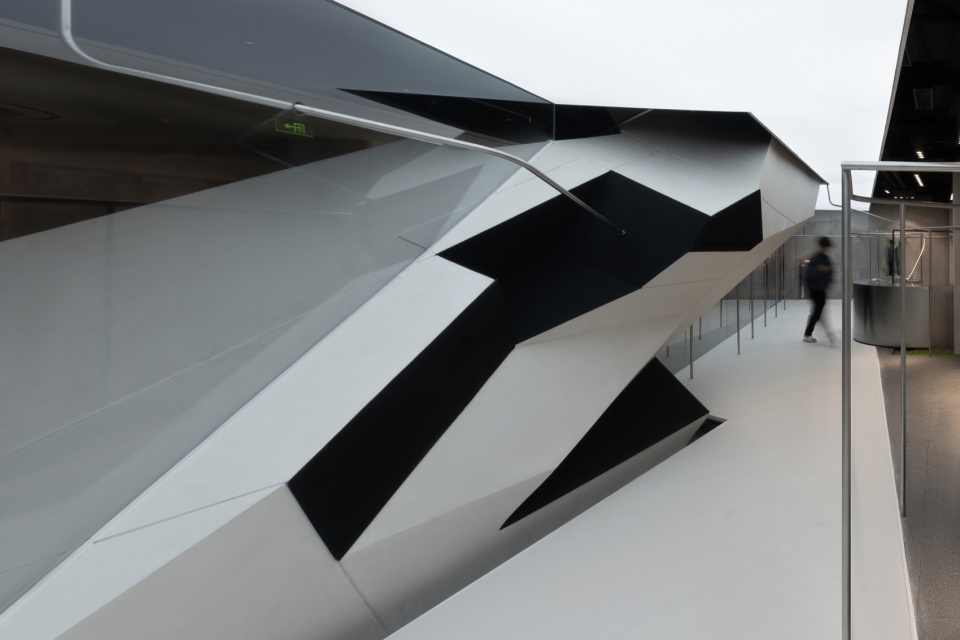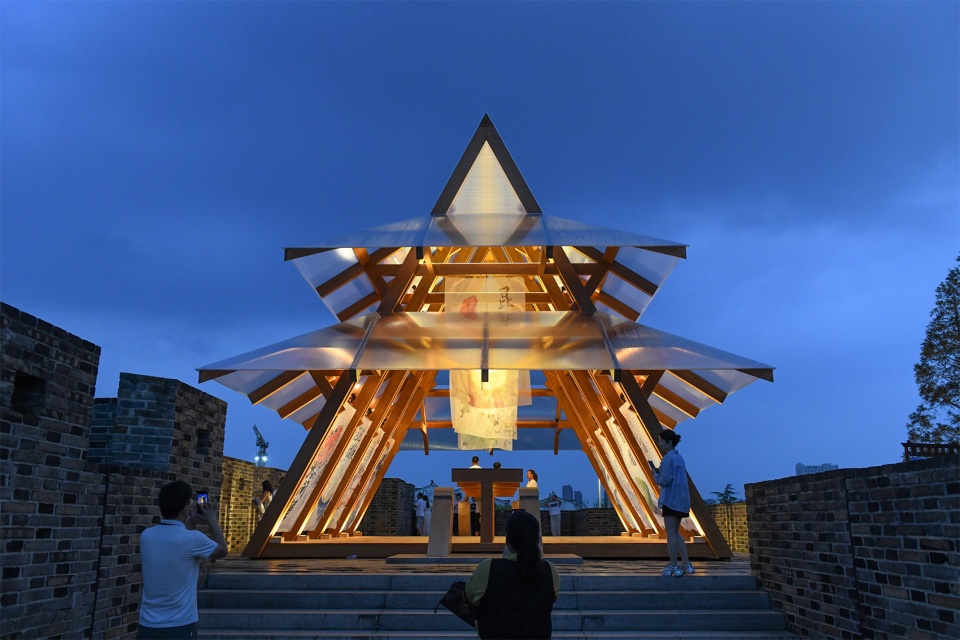

场地实勘感受得设计操作思路九条:1.大门后退,让门房于外,便可引势于内,解入口巷窄游人闪过之困。2. 理过道上下以求空简,下减水景踏步,上闭墙头杂景,取未入室内,意境先行。3. 前行内外边界,主屋大门必精致有心,把手独特。4. 前厅两要事,接待与分流,餐食与住宿各明去处。5. 内庭有天井多间围合,与大厅开墙洞以求畅阔,拆旧格以除杂乱,开窗理光取景。下属餐厅上为客房,此区为整体功能中心,必上下层整体兼顾,闭视线引顶光顾隔声通达实用,二层客房形无二同,需逐一思虑,提优避劣,和而不同。6. 梳理院内水池南阔,院中围屋破墙为透,改茶食轻亭上叠,水面下藏。意连通前后两院之势,化院为园。7. 选前院一侧加连廊,穿围屋轻亭南侧为后院,此区气韵松闲,功能舒散。东侧茶室,西侧寝楼。8. 茶室邻家三合,唯下理平窗以闭视野,上开采光以求氛围。寝楼开窗即屋脊青瓦连绵,室内功能整理配合观景。后院邻家茂竹欲求不得,必开墙以求竹影摇曳,翠窗逼眼。9. 另天台实勘早中晚三景,可俯瞰古村全貌,观日月生落,牛郎北斗。可力掘功用,以待美景星辰。 (勘地归程车中小记)
Nine considerations for the space reforming based on the site visit:1. Retreating the main gate to allow the gate to reveal, which can guide momentum inward, alleviating the narrowness of the entrance alley and the inconvenience for passing visitors.2. Simplify the passage layout vertically to create an airy atmosphere. Reduce water features at ground level, enclose miscellaneous views above the wall, keeping them out of sight, emphasizing the artistic conception.3. Refine and pay attention to the boundary between the interior and exterior. The main entrance of the main building must be delicately crafted and unique in its door handle.4. The front hall serves two main purposes: reception and diversion, clearly delineating the areas for dining and accommodation.5. The inner court is surrounded by several enclosed spaces with a patio. Open the walls facing the main hall to create a sense of spaciousness. Rearrange existing structures to eliminate clutter, optimize lighting, and frame views through windows. The restaurant below the guest rooms, serves as the central hub of the facility, ensuring coherence between the upper and lower levels, with attention to sightlines, natural lighting, sound insulation, and practicality. Each guest room on the second floor is unique and requires careful consideration to optimize strengths and mitigate weaknesses, to achieve harmony through diversity.6. Expand the water pond in the southern part of the courtyard. Demolish walls around the courtyard houses to create openness and stack a light pavilion above the water, concealing the water surface beneath. This integrates the front and rear courtyards, transforming them into a unified garden.7. Add a connecting corridor on one side of the front courtyard, leading to the rear courtyard through the pavilion and courtyard houses. This area exudes a relaxed atmosphere and serves multiple functions. The eastern side houses serves as a tea room, while the western side accommodates guests.8. The tea room adjacent to three other sides, with only one window opened at the bottom to introduce the selected view, while the upper openning allows natural light to enhance the ambiance. The sleeping quarters open up windows to a continuous view of the green-tiled roofs, coordinating interior functions with scenic vistas. The neigbour’s courtyard full of the lush bamboo we desired, so walls shall be opened up to invite the swaying shadows of bamboo, creating an inviting atmosphere through verdant windows.9.Explore the rooftop at different times of the day—morning, noon, and night—to capture panoramic views of the ancient village, witness the sunrise and sunset, and observe celestial phenomena. Maximize functionality to appreciate the beauty of the stars and landscapes.(“Small Notes from the Return Journey in the Field Survey Car”)
▼餐厅概览,overview of the restaurant©汪敏杰
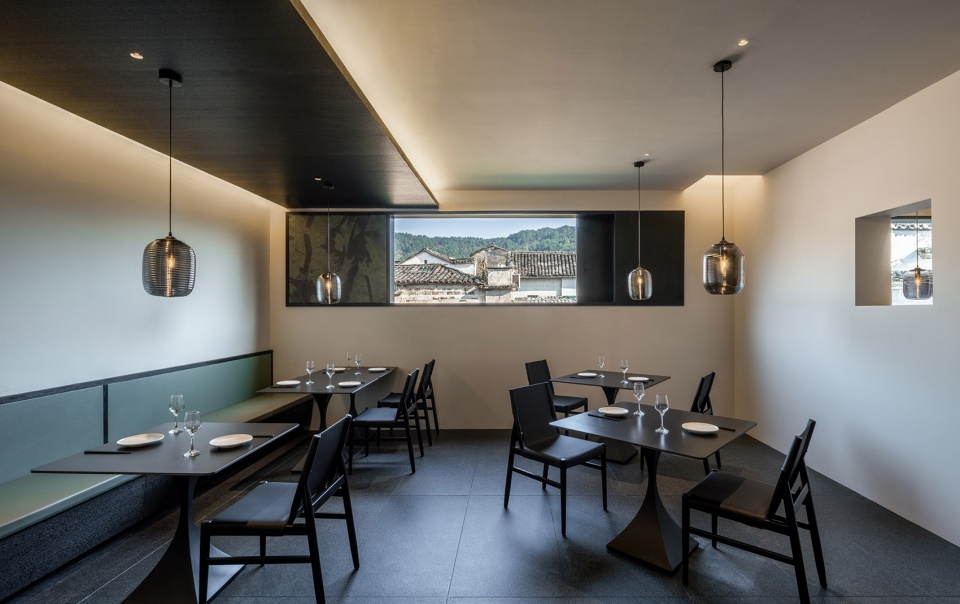
缘起Foreword
接到项目委托是在二三年的四月,徽州天气微凉,宏村游人还不很多,院内桂树下藤椅散坐,安静、闲散,阳光晒的身体暖热,恍惚间不知身在何处。关于项目的功能和设想也在这最初的沟通中酝酿发酵。项目功能是以餐茶为主营方向的民宿,地处安徽宏村景区中心,是两代人在祖宅基础上数次购买增扩,基地邻里边界复杂。建筑加建改造多次,结构信息模糊。场地实勘煞费心思,还好之前改建房东都全程亲历,逐一详解告知。传统民居改造总是有些包袱,可拆可留的装饰构件太多,拆除显得略有可惜,保留则除了对民俗和房主的情感尊重已别无意义。这些斟酌与决策让我们颇费了些气力。项目踏勘游走体测数遍,回杭途中阿施驾车,我蜷在副驾用手机记事本潦草写了开篇文字,完工后整理文字才忆起翻出。惊喜虽后期过程有诸多操作调整,关于项目改造的原初意愿竟未曾移改。
▼草图,sketch©边界空间设计
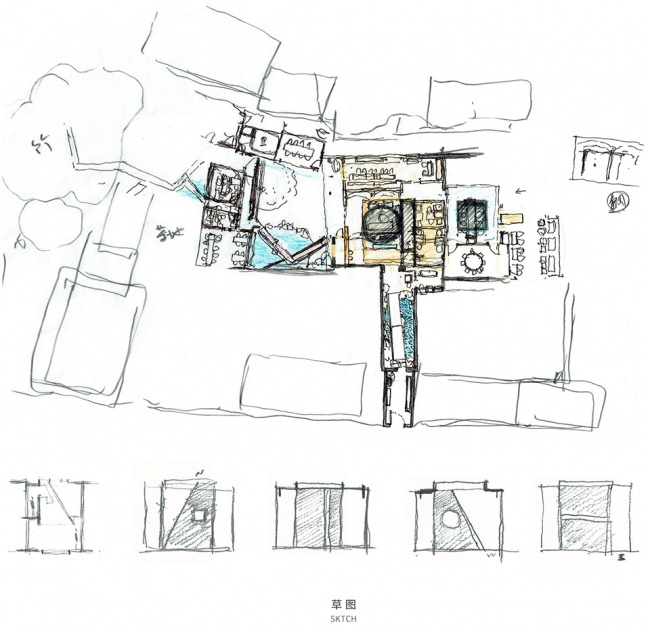
The commission came in April of 2023, with the weather in Huizhou slightly cool and the number of tourists in Hongcun Village still low. Under the cassia trees in the courtyard, wicker chairs were scattered around, creating a quiet and leisurely atmosphere. The warm sunlight enveloped the body, making it feel cozy and relaxed, almost as if one was lost in time and space. It was during this initial communication that the project’s functions and ideas began to take shape. The project focused primarily on guest accommodation with a strong emphasis on dining and tea services. Situated in the heart of the Hongcun scenic area in Anhui, it had undergone multiple expansions over the generations on the basis of the ancestral home, resulting in a complex layout of neighboring boundaries. The building had been renovated and expanded multiple times, resulting in blurred structural information. The site survey required meticulous attention to detail, but fortunately, the landlords who had been involved in the previous renovations were there to provide detailed explanations. Traditional house renovations always come with some challenges. There were too many decorative components that could either be removed or retained, and the decision-making process was not easy. Demolition seemed somewhat regrettable, while retaining them seemed to serve no purpose other than respecting folk customs and the emotional attachment of the homeowners. These considerations and decisions required considerable effort.We conducted multiple surveys and measurements of the site, and on the way back to Hangzhou, I huddled in the passenger seat, hastily jotting down the opening words on my phone’s notepad. It was only after the completion of the project that I remembered to retrieve and organize the notes. Surprisingly, despite the numerous adjustments made during the later stages of the project, the original intention behind the renovation remained unchanged.
▼餐厅外观,restaurant facade©汪敏杰
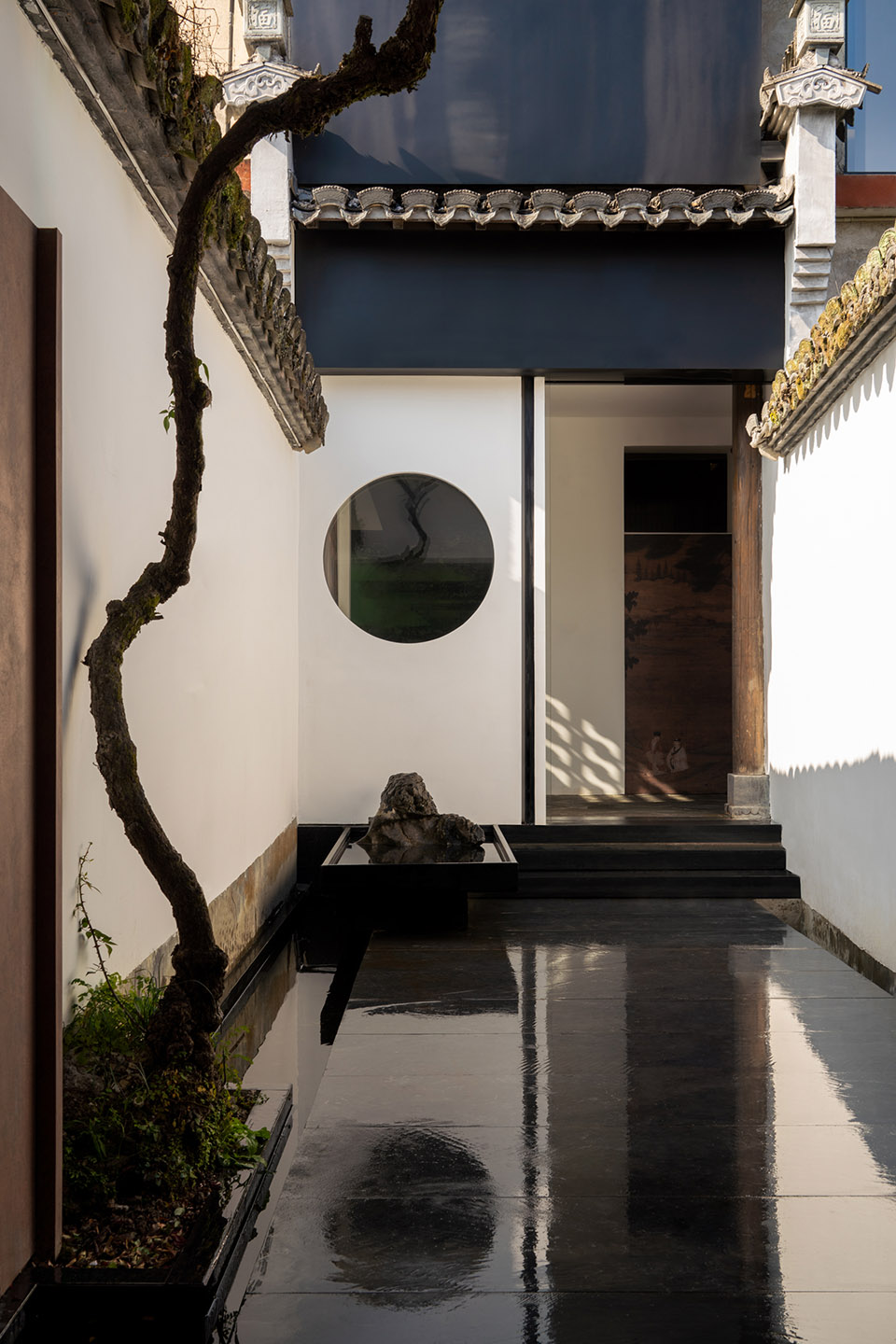
遮蔽与渗透Concealment and Penetration
主体建筑一楼设接待与餐厅,二层客房。院落与其他建筑作辅助功能。实勘分析,我们认为主体建筑构造是围绕天井分布的多个关系不明确的小“间”,彼此多隔分少交集,天井原顶已加钢梁三分天空,上覆玻璃,有天光直泻,不可落雨。一二楼房间都直面天井而围,视野声音四通。隔分和连通相互的边界限定,通过空间的相互遮蔽与渗透,建立新的空间关系是解决这些矛盾的解药。
The main building’s ground floor is designated for reception and dining, while the second floor houses serves as guest rooms. The courtyard and other structures serve auxiliary functions.Through our on-site analysis, we believe that the main building’s structure consists of several small “rooms” distributed around a patio, with unclear relationships between them. They are mostly separated with minimal intersections. The original roof of the patio has been replaced with steel beams supporting a glass roof, allowing direct sunlight but preventing rainwater from entering. Both the rooms on the first and second floors directly face the courtyard, creating an open visual and auditory environment. Defining boundaries between these rooms, whether separating or connecting, and establishing new spatial relationships through the concealment and penetration of space, is the key to resolving these contradictions.
▼自餐厅06B区域向上望,view from area 06B of the restaurant©汪敏杰
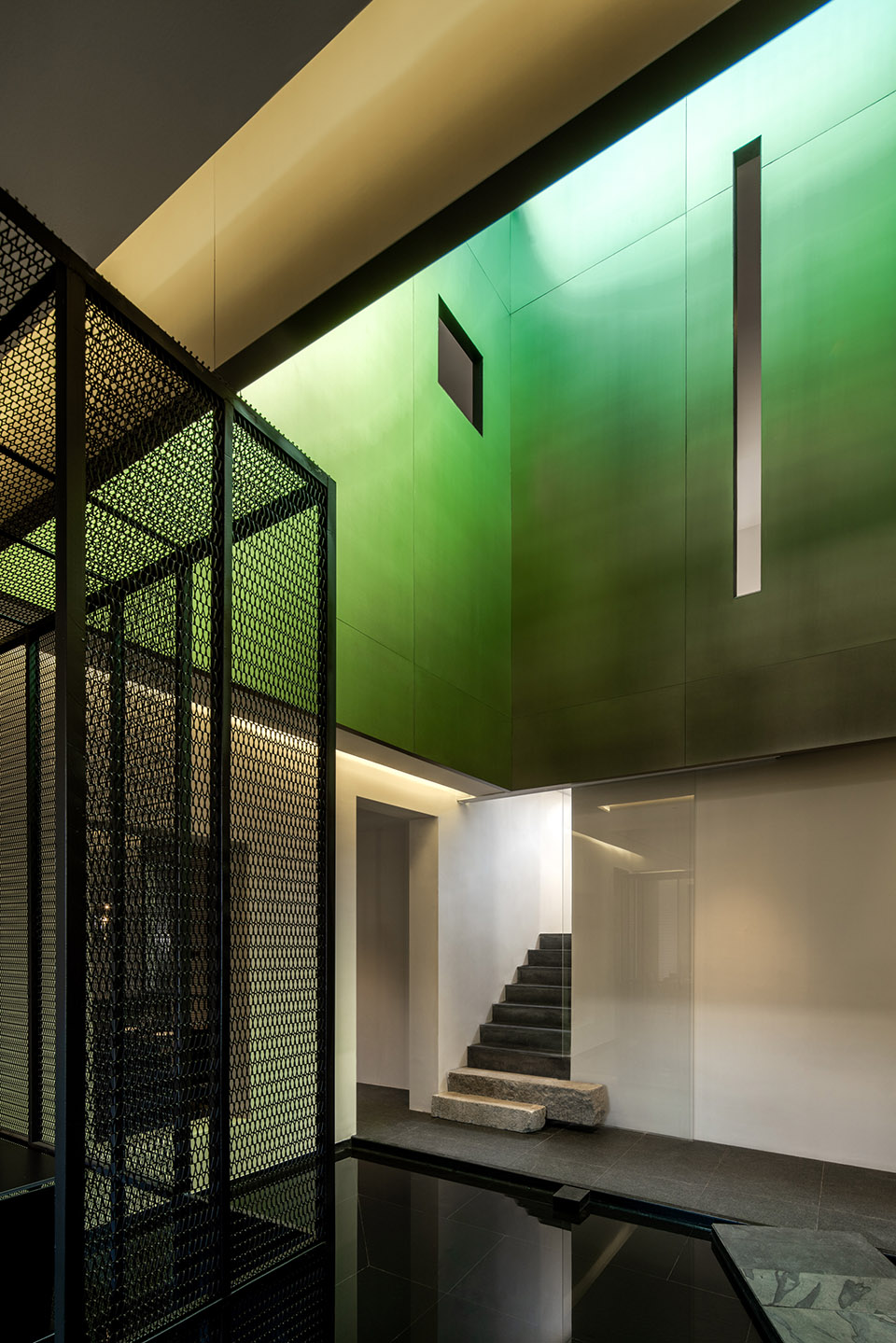
中央天井区的处理我们采取上下隔分,用倒漏斗型的围合墙体在二层围廊三分天井,形成回廊。一二楼各分得1/3和2/3的天光,解决了上下层各自的采光同时,也解决了功能分区,视线遮蔽与隔音。一层餐厅区保留高挑的天井有天光下探,二层因为“漏斗”造型的分割使得回廊四通,内向开窗可使上下窥望,互视成趣。
▼中央天井区草图,draft of central patio area ©边界空间设计

In handling the central patio area, we opted for a vertical division, creating a funnel-shaped enclosure on the second-floor corridor, dividing the courty into three sections. This configuration forms a corridor. Each floor receives one-third of the skylight respectively, addressing the lighting needs of both levels while also addressing functional zoning, sightline obstruction, and soundproofing. The restaurant area on the ground floor retains a lofty patio with sunlight filtering down, while the second floor, due to the “funnel” shape, allows for a four-way corridor configuration. Windows facing inward on the second floor enable occupants to peek up and down, creating an engaging visual interplay.
▼天井区2F南侧走道向东望,patio area of south walkway looking east on 2F ©汪敏杰
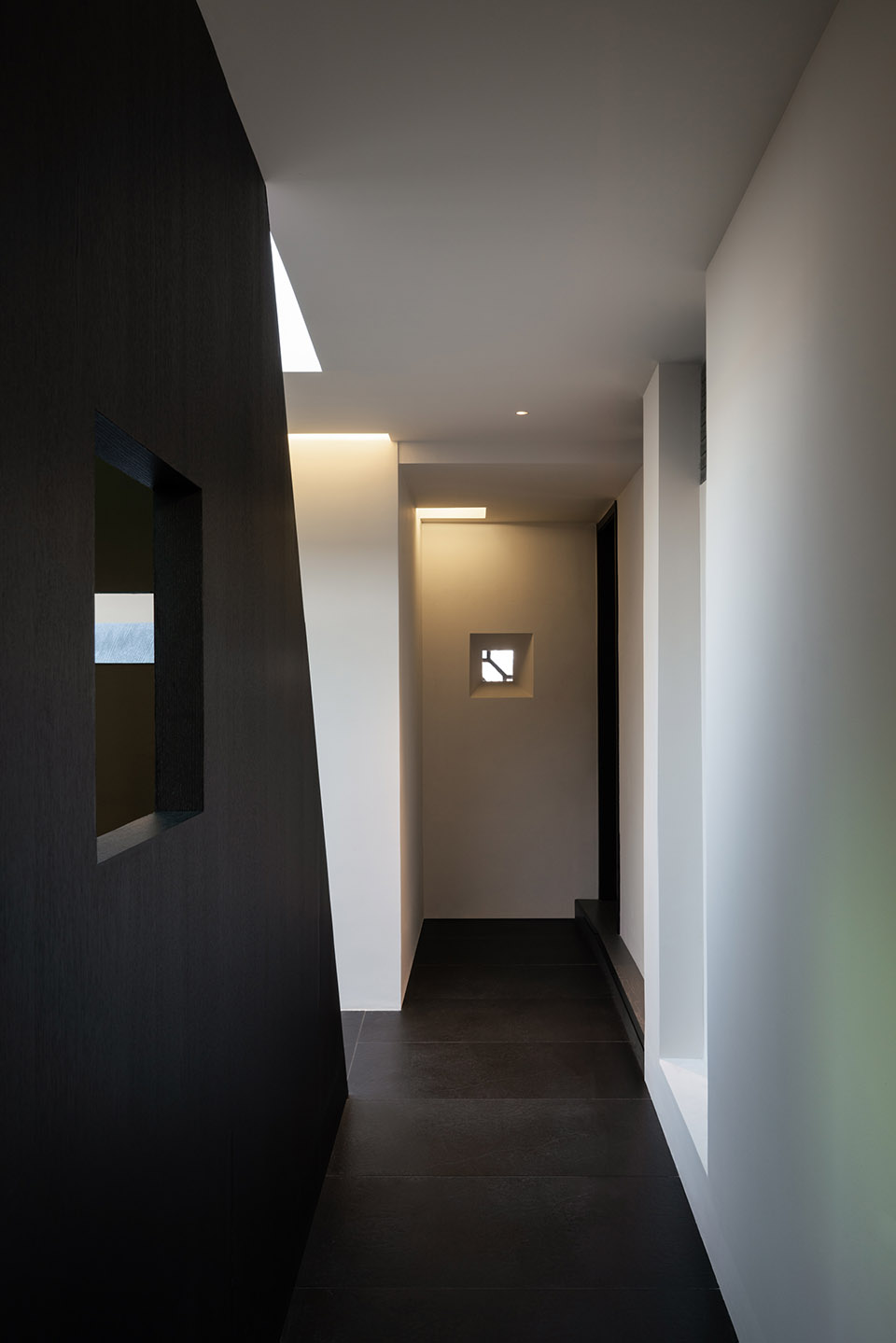
▼天井区2F南侧走道向西望,patio area of south walkway looking west on 2F ©汪敏杰
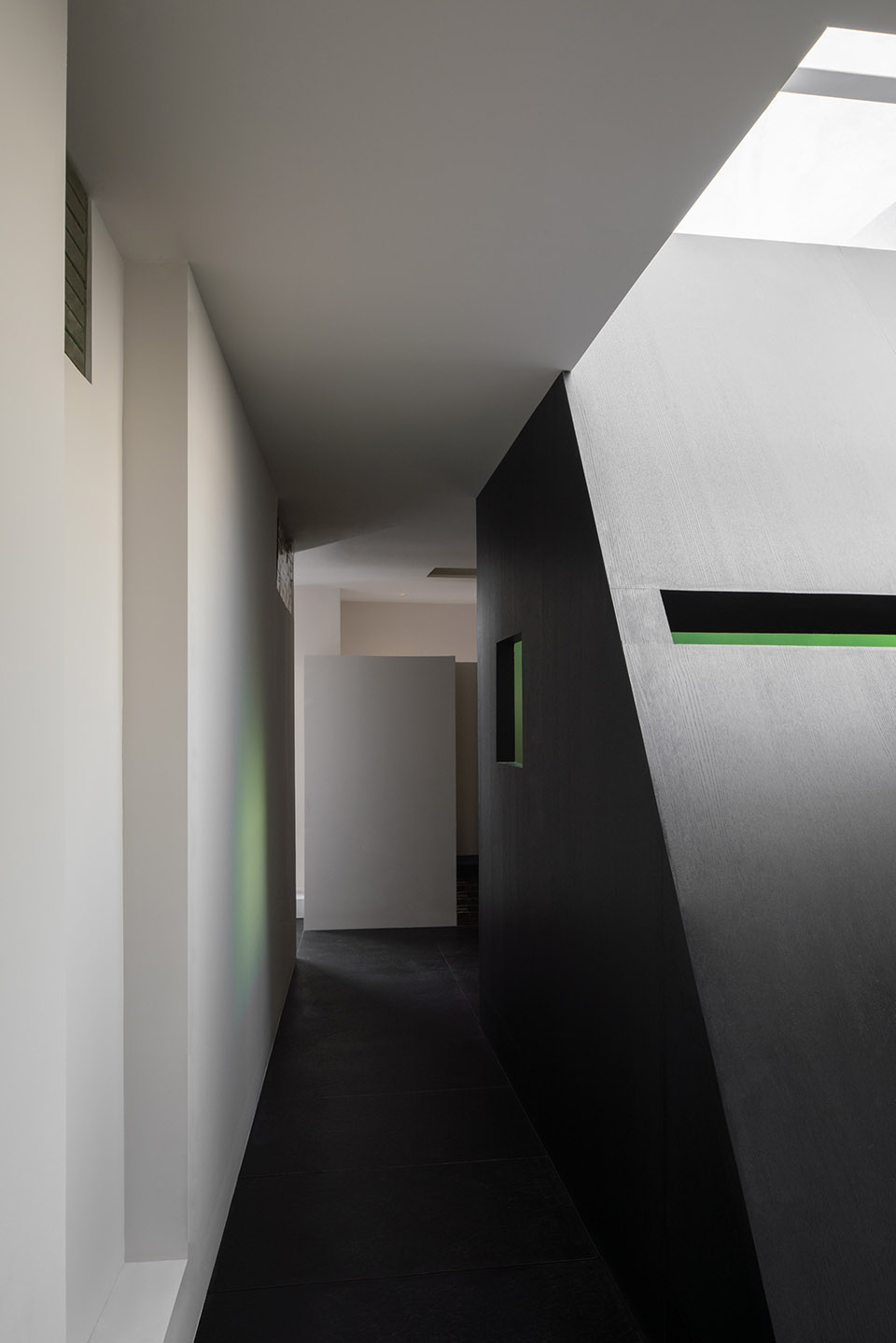
▼天井区2F北侧走道向东望,patio area of north walkway looking east on 2F ©汪敏杰

前厅设接待引导分流客人,厅中凿一浅池与旁侧厚壁相切,人绕圆池环行,池中一柱一石,池水倒影巨幅若归墟般深邃青绿图像。厚壁为原建筑废弃楼梯封改,留孔意为多窍太湖石意向,孔内再置石点题,以营造松弛的东方山水意像。孔洞与门洞连通餐区,餐厅之貌若隐若现,似窥似探,引人前往……
The front hall serves as a reception area, guiding and directing guests. Within the hall, a shallow pool is carved, seamlessly integrated with the thick walls on one side. Visitors circulate around the circular pool, where a single pillar and stone are placed, and the reflection in the water resembles a vast, profound, and verdant image reminiscent of ancient ruins. The thick wall conceals the abandoned staircase of the original building, symbolizing the intention of multiple openings akin to the famous Taihu stone. Within these openings, additional stones are strategically placed, evoking a relaxed ambiance reminiscent of traditional Eastern landscapes. The openings connect to the dining area, where the restaurant’s appearance is subtly revealed, enticing guests to explore further.
▼接待区域水景立柱细部,reception area features column details ©汪敏杰
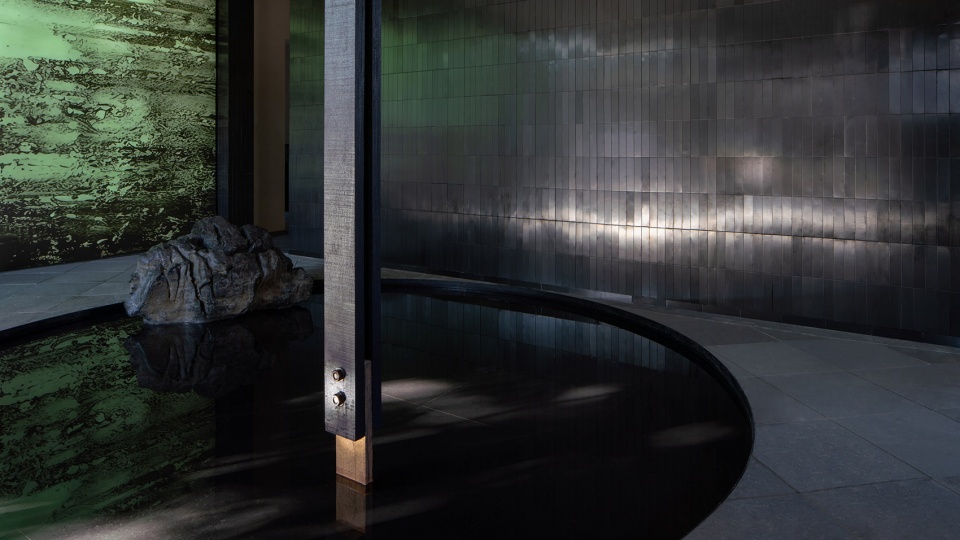
▼接待区域水景,reception area water view ©汪敏杰
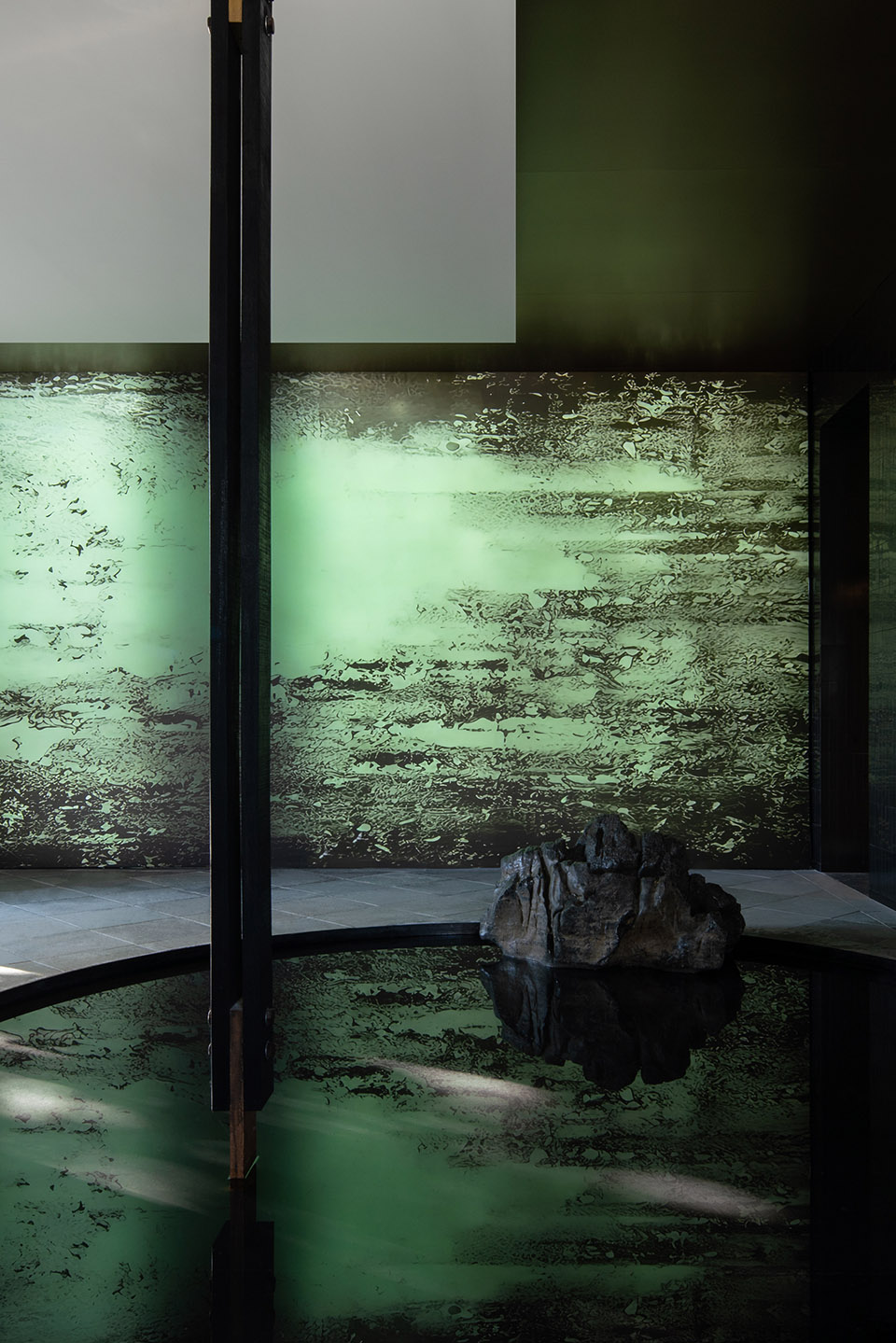
▼厚壁凹龛,thick-walled recess©汪敏杰

若处理一二层之间的关系用“隔分”来概括,那一层可以概括为“连通”。多个横向空间的处理用“穿墙破壁”来形容恰当不过,用窗口和门洞来连通和模糊各个空间的界限,使其变成一个若太湖石般多孔多窍的整体,彼此间对望互成,营造深远的空间关系,增强空间体验。使得多个独立的小间变成彼此相互呼应联系的室内“园林”。扩建原有天井中心水池,下设步石小径互通,上映天光流云。天井内壁金属板的饰面透着铜绿,与窗外的青绿、前厅的青绿,厚壁孔洞的青绿和饰画的青绿相应,映射出婉约清透的意蕴。
If we summarize the relationship between the first and second floors as “separation” and characterize the first floor as “connectivity,” it would be appropriate. Describing the handling of multiple horizontal spaces as “breaking through walls” is quite fitting. By using windows and doorways to connect and blur the boundaries of various spaces, they become an integrated whole, akin to a porous and perforated Taihu stone. They mutually face each other, creating profound spatial relationships and enhancing the spatial experience. Thus, the multiple independent rooms are transformed into an interconnected indoor “garden.” Expanding the original central pool in the patio and creating interconnected pathways with stepping stones enhances the reflection of sunlight and clouds above. The metal panels on the courtyard’s inner walls emit a copper-green hue, echoing the greenery outside the windows, in the front hall, within the thick walls’ openings, and in the decorative paintings, projecting a subtle and transparent aesthetic.
▼自餐厅06B区域望向接待区,looking towards the reception area from area 06B of the restaurant©汪敏杰
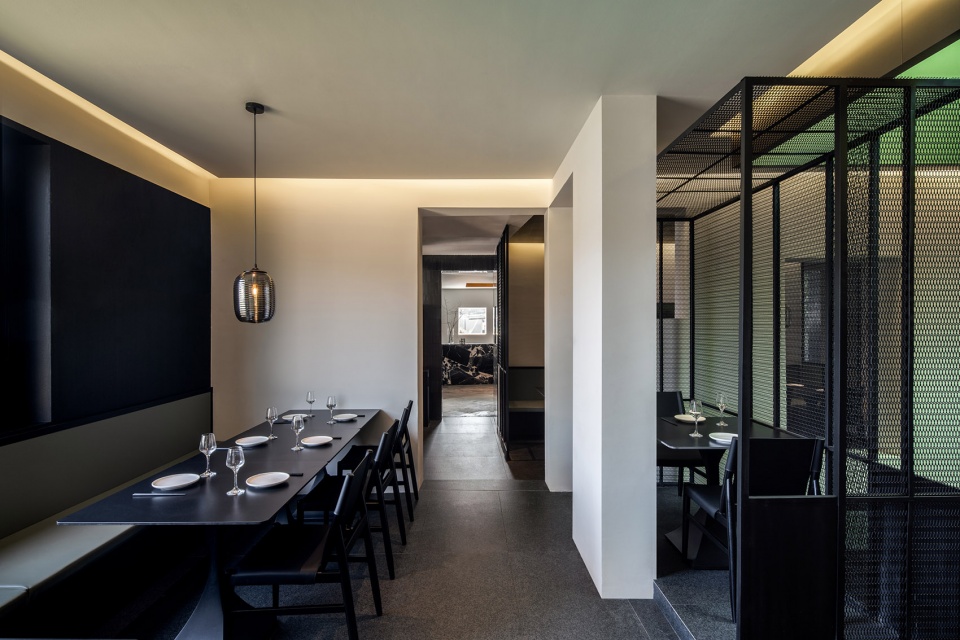
▼自1F天井区域向东望,Look east from patio area on 1st floor ©汪敏杰
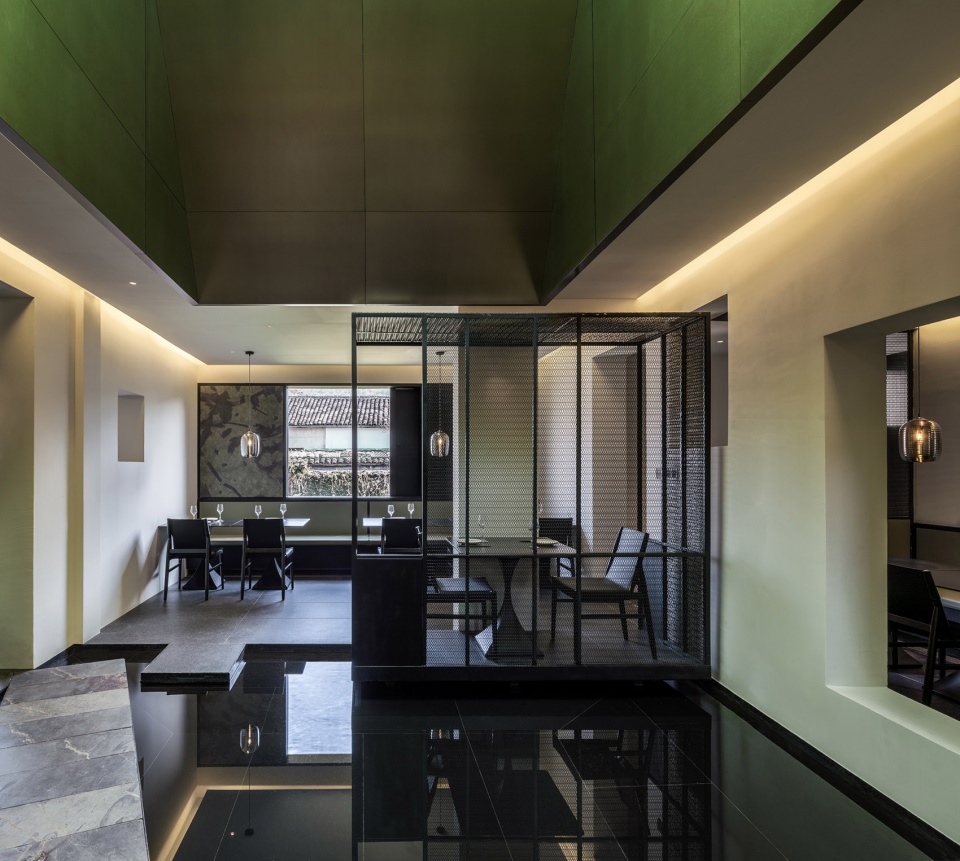
▼自1F天井区域水池踏步望向餐厅洞口,you can see the opening of the restaurant from the pool in the patio area©汪敏杰
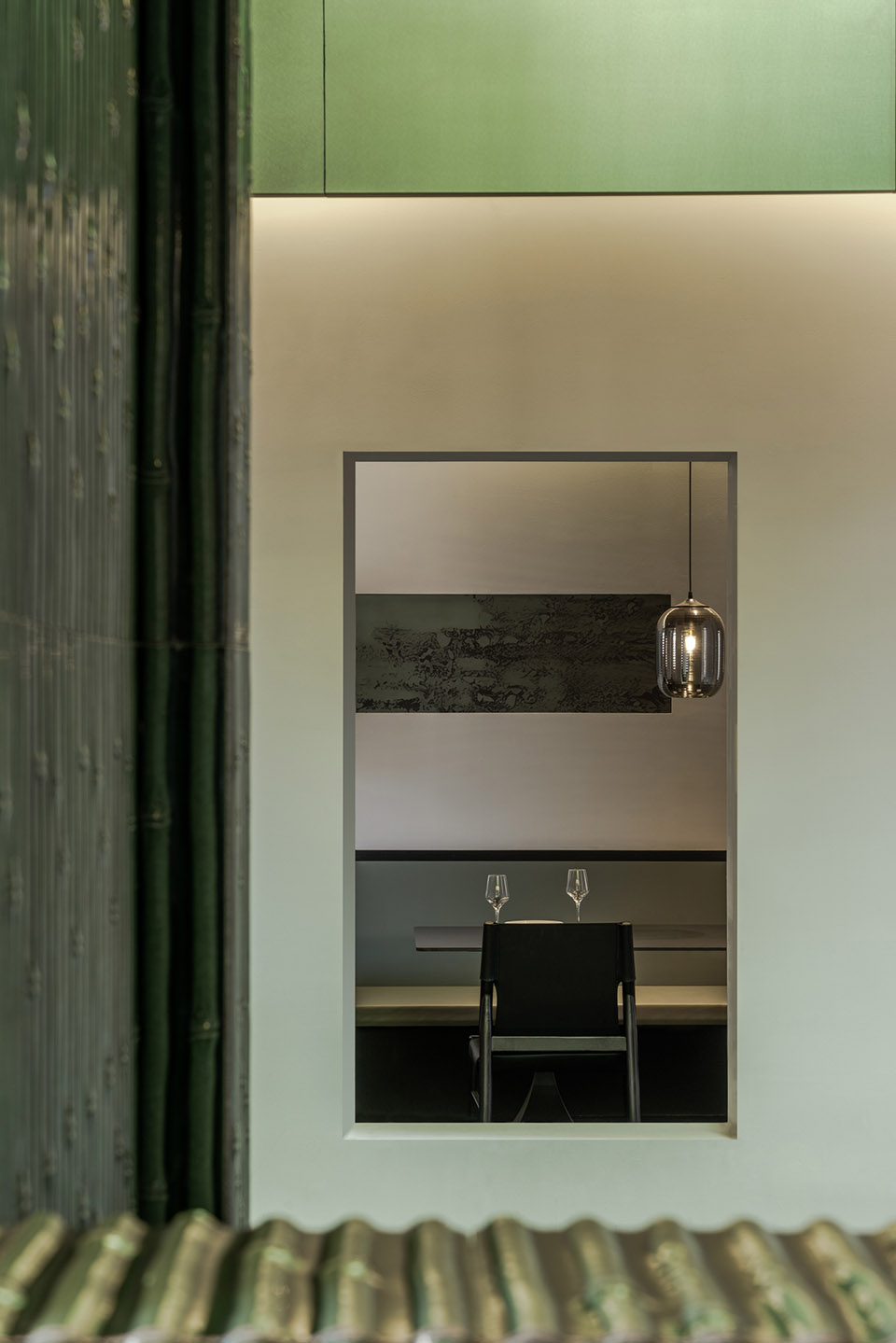
前院的曲廊是为整合庭院流线初衷而设,原意希望扩大水池伸于轻亭之下,使得感受水面无限和亭的轻盈从而双向获利,当然池上的曲廊更有实用,池中设两片折墙,廊紧靠折墙互设,从墙缝伸出。折墙横向分隔庭院,使庭院分大小两区,生出大小、明暗、向背和虚实。廊连通主体建筑与轻亭,绕道墙后,人影流动的虚实关系颇有趣味。 曲廊的两片黑色钢顶在中部压低叠合,落水收于此处,汇于池水。江南多雨,曲廊内侧的空间尺度与水声,最适宜这落雨的天气。
The winding corridor in the front yard was originally designed to integrate the flow lines of the courtyard. The initial intention was to expand the pool area beneath the light pavilion, creating a sense of boundlessness over the water surface and the lightweight structure of the pavilion, thereby benefiting both visually. Of course, the practicality of the winding corridor over the pool is undeniable. Two folding walls are installed in the pool, with the corridor snugly attached to them, extending from the gap between the walls. The folding walls horizontally divide the courtyard into two areas, creating a contrast in size, brightness, orientation, and solidity. The corridor connects the main building with the light pavilion, and as it winds around the walls, the interplay between light and shadow created by the moving figures adds a touch of interest. The two black steel roofs of the winding corridor are lowered and overlapped in the middle to collect rainwater, which then flows into the pool. In the rainy regions of Jiangnan, the scale of the space inside the winding corridor and the sound of water are most suitable for such weather conditions.
▼在客房阳台望向曲廊,from balcony looking out onto the winding corridor©汪敏杰
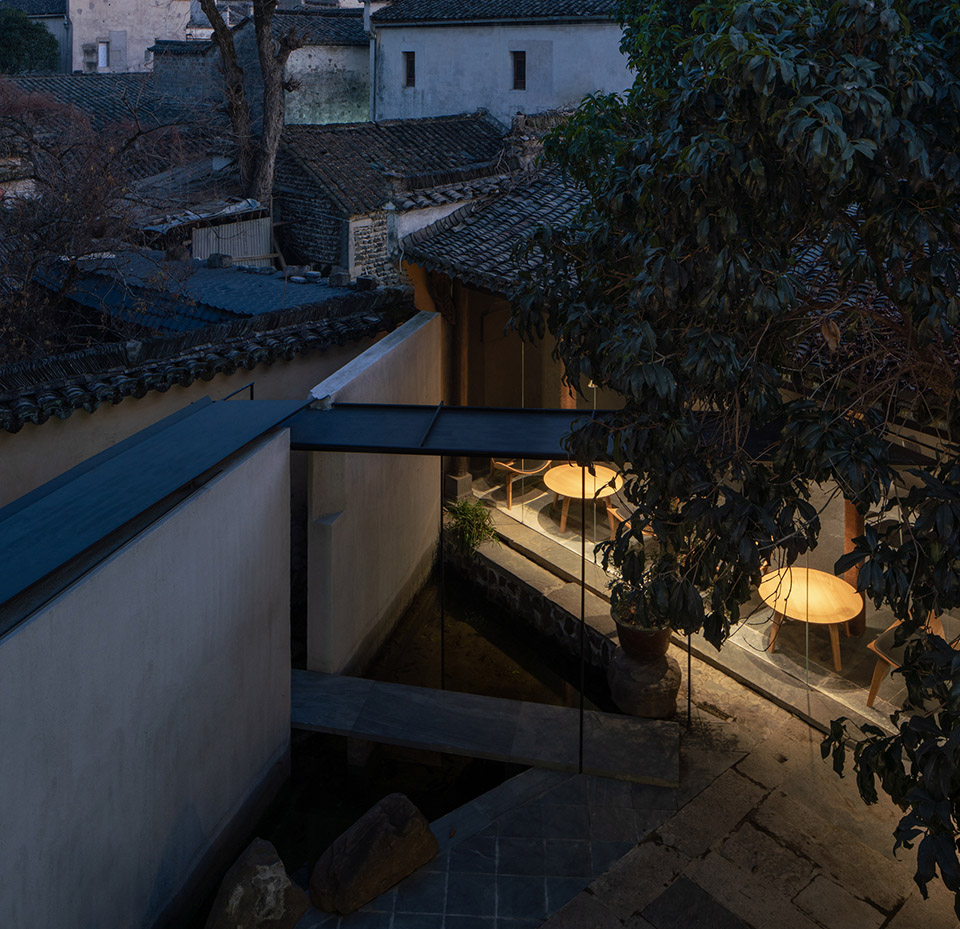
院中轻亭是内向的,由原来的围屋中段分开大小两间,大间紧邻水池做餐厅延展补充,小间(“黑屋”)做书房小歇。面向前院和彼此相对的立面都改隔墙为玻璃,求得轻盈通透。内部全设黑色,作为外观大片玻面的底色,而身处暗色室内更能感受阴翳光线下的慢时光。
The light pavilion in the courtyard is inward-facing, separated into two differently sized sections from the middle of the original enclosed structure. The larger section is situated adjacent to the pool, serving as an extension of the dining area, while the smaller section is designated as a study or relaxation space. The walls facing the front courtyard and each other have been replaced with glass, enhancing the sense of lightness and transparency. The interior is entirely black, serving as a backdrop to the large expanses of glass, and being in the dark interior enhances the experience of slow-paced moments in the shadowy light.
▼轻亭近景,close view of light pavilion©汪敏杰
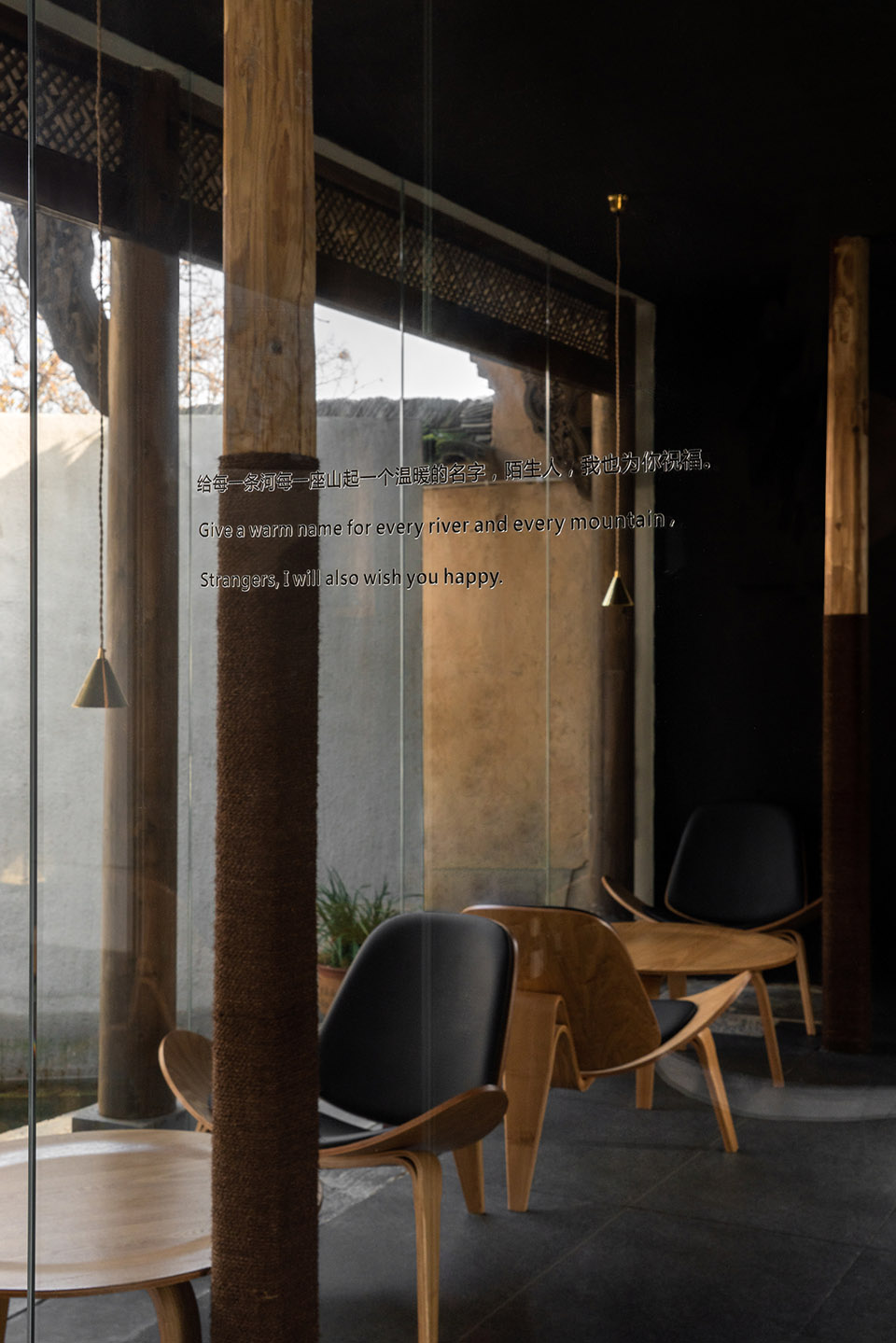
▼黑屋近景,close-up view of the black room©汪敏杰
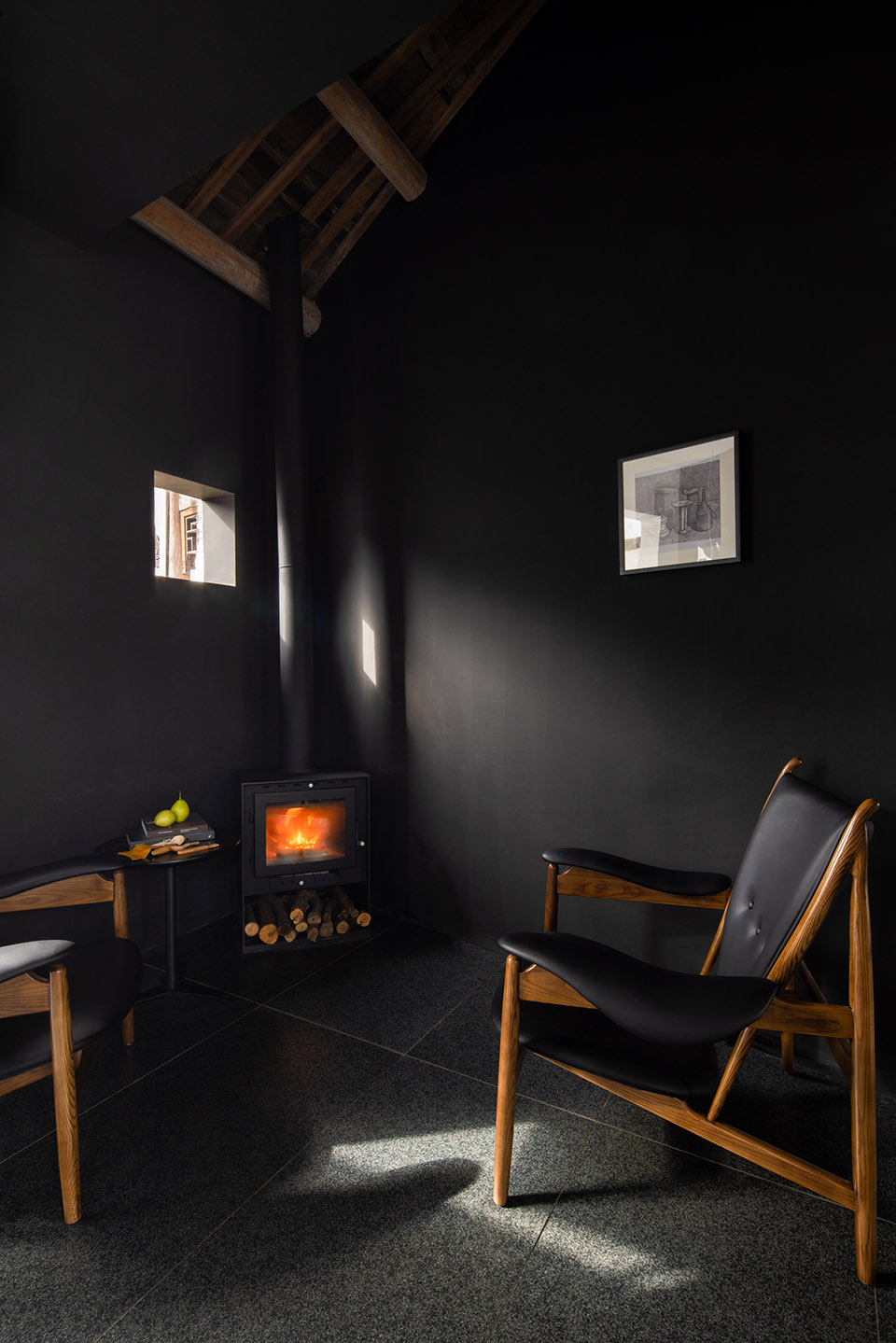
茶室设在后院的独立小室,原是三面探入邻家的一个仓房,整理天窗与侧窗,终为一光线柔和的条形茶室,适合数人茶席小聚。
The tea room is situated in a separate small building at the back of the courtyard, originally a storage shed protruding into the neighboring property on three sides. After renovating the skylight and side windows, it has been transformed into a tea room with soft and gentle lighting, suitable for intimate tea gatherings of several people.
▼轻亭与黑屋之间通向茶室的小径(左)与茶室内部(右),the path leading to the tea room between the Light Pavilion and the Black room (left) and the inside of the tea room (right)©汪敏杰
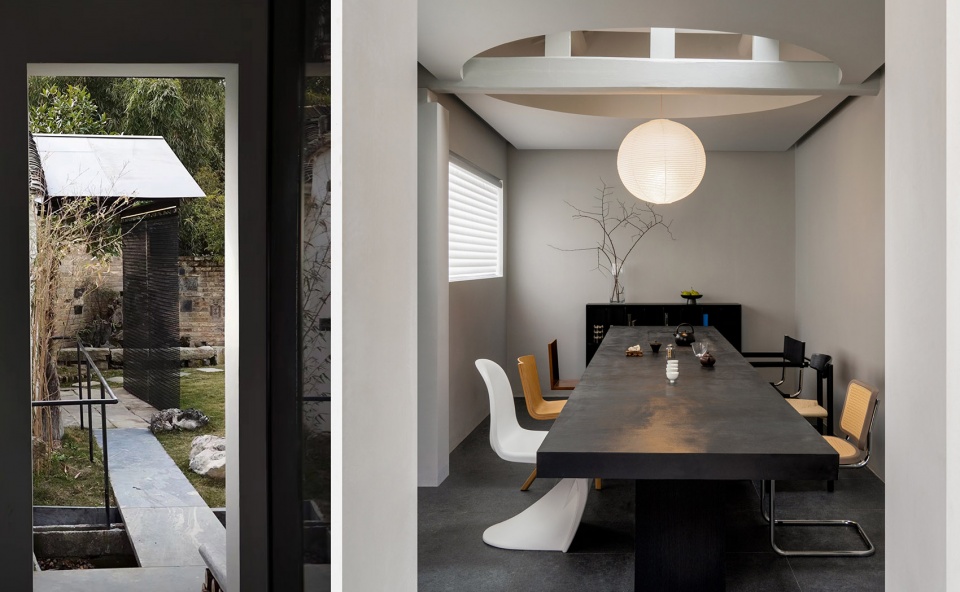
客房均设在二层,避杂乱日常,独享自我天地。因依原建筑整合梳理,房间形无二同,开窗风景也各有取向,或院外青竹碧眼,或古村屋脊连绵……
The guest rooms are all located on the second floor, providing a retreat from the hustle and bustle of daily life, allowing guests to enjoy their own private space. Due to the integration and reorganization of the original building, each room has a unique shape and orientation, and the views from the windows vary. Some overlook the verdant bamboo outside the courtyard, while others offer vistas of the continuous rooftops of ancient village houses.
▼窗洞的亚克力在夕阳的照射下散发神圣的光芒,the acrylic in the window holes radiates sacred light in the setting sun©汪敏杰
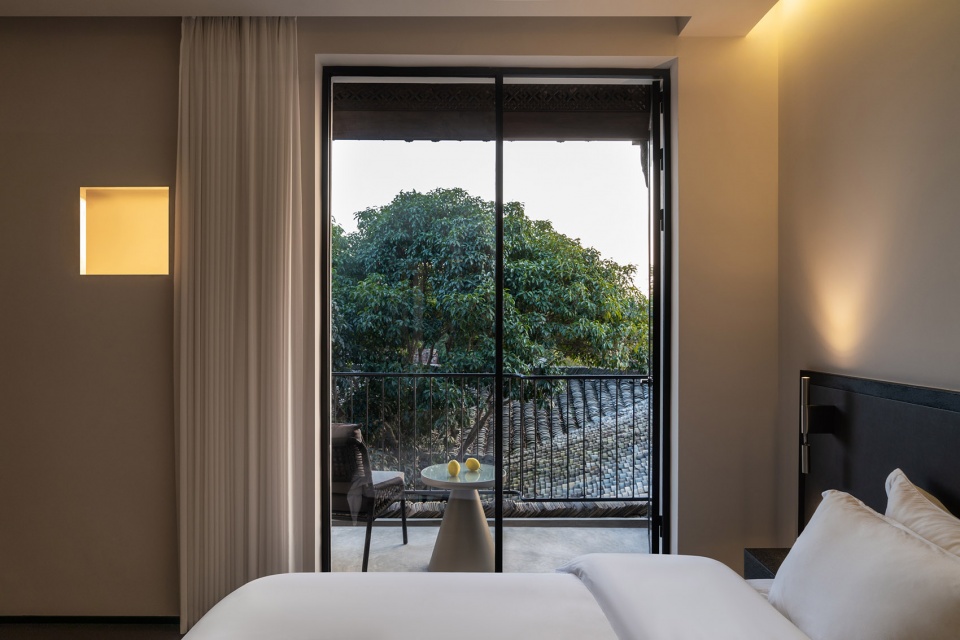
▼客房02F,room 02F©汪敏杰
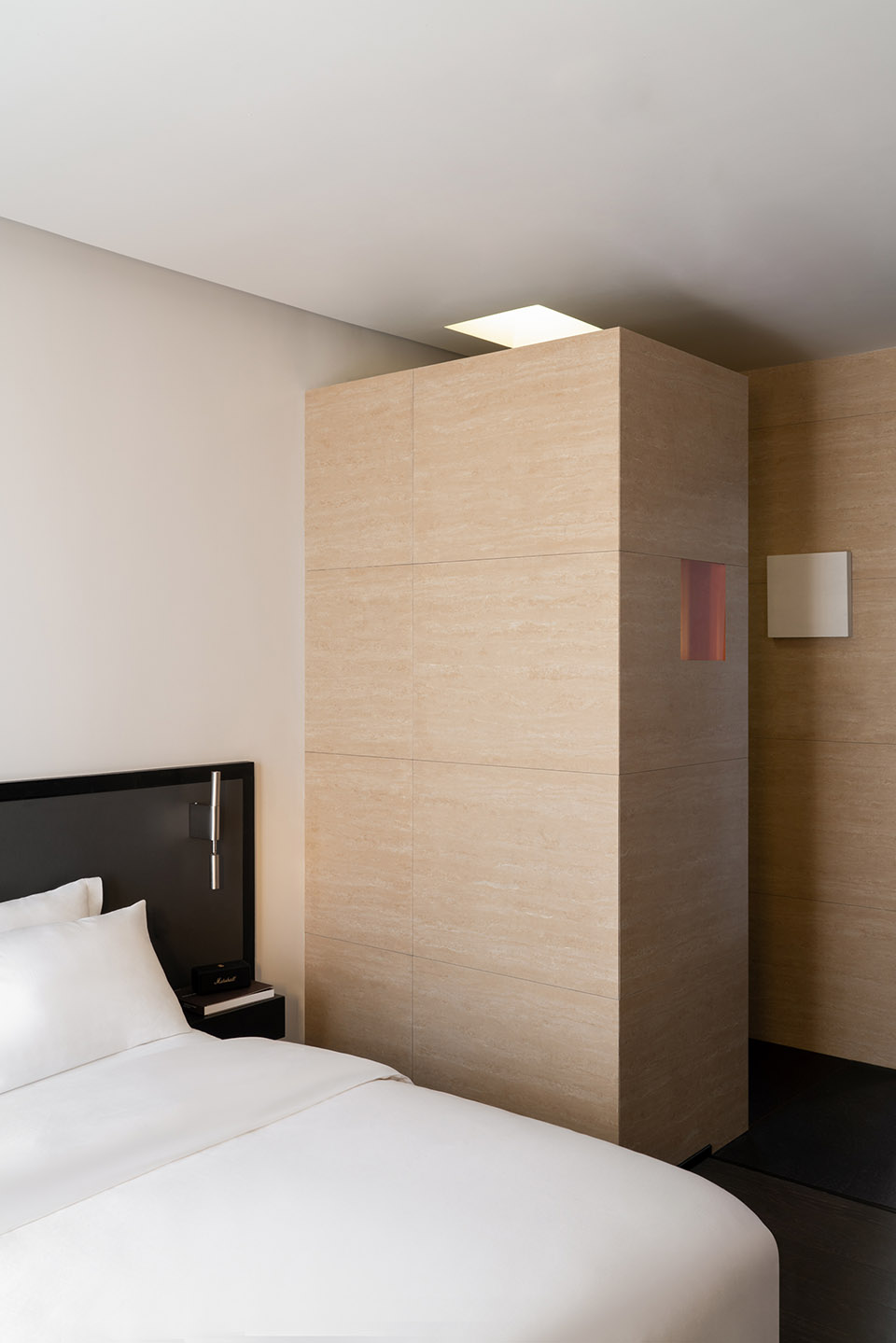
结语Epilogue
项目整观,从面长巷而开的入口,内行的过道,再到前厅与餐区,客房以及行至庭院、曲廊、轻亭及后院,都在强调空间遮蔽与渗透的操作中,空间漫游带给体验者游园般的身体感。
The overall view of the project, from the entrance opening onto a long alley, through the interior passageways, to the foyer and dining area, guest rooms, and then to the courtyard, winding corridor, light pavilion, and rear yard, all emphasize the manipulation of space through concealment and penetration. The roaming through space brings about a bodily sensation akin to wandering through a garden for the experiencer.
▼客房02D,room 02D©汪敏杰
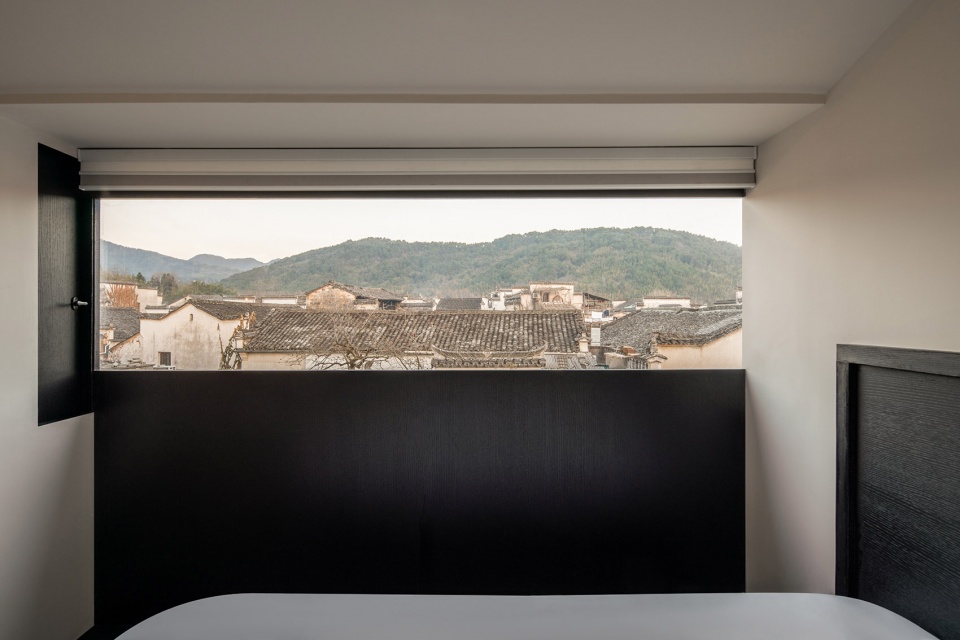
在建筑和空间沦为媒体符号和网络流量的今天,我们仍然强调空间的体验感。正如传统园林所倡导的行、望、居、游一样,关注空间中身体移动的丰富感知与主体体验。
In an era where architecture and space often become mere symbols in media and internet traffic, we still emphasize the sensory experience of space. Similar to the principles advocated by traditional gardens, which emphasize walking, viewing, dwelling, and wandering, we focus on the rich perception of bodily movement and subjective experience within space.
▼后院客房,backyard room©汪敏杰

题外(空间的钥匙)Others “Key to Space”
曲廊片墙的短墙上有一缺口,我们戏称这是空间线索的钥匙,它牵出一条贯穿项目南北轴线空间上的一系列开洞,站在最北侧的餐厅,视线可以穿过餐厅中区、前厅、曲廊片墙的缝隙、轻亭、直到后院的茶室。曲廊片墙上的缺口,正是为了这视线穿过的躲闪。也是项目中多次“穿墙破壁”的空间遮蔽与渗透操作的副产品——或许也算做这操作背后的点题。
The short wall of the winding corridor has a gap, which we jokingly refer to as the “key” to spatial clues. It leads to a series of openings along the north-south axis of the project. Standing in the northernmost part of the restaurant, one’s line of sight can pass through the central area of the restaurant, the foyer, the gap in the winding corridor wall, the light pavilion, all the way to the tea room in the rear yard. The gap in the winding corridor wall is deliberately created to facilitate this line of sight. It is also a byproduct of the spatial manipulation of concealment and penetration, which is a recurring theme in the project – perhaps it could be seen as a symbol behind these practices.
▼午后阳光洒落在曲廊斑驳的墙面上,the afternoon sun fell on the dappled walls of the gallery©汪敏杰
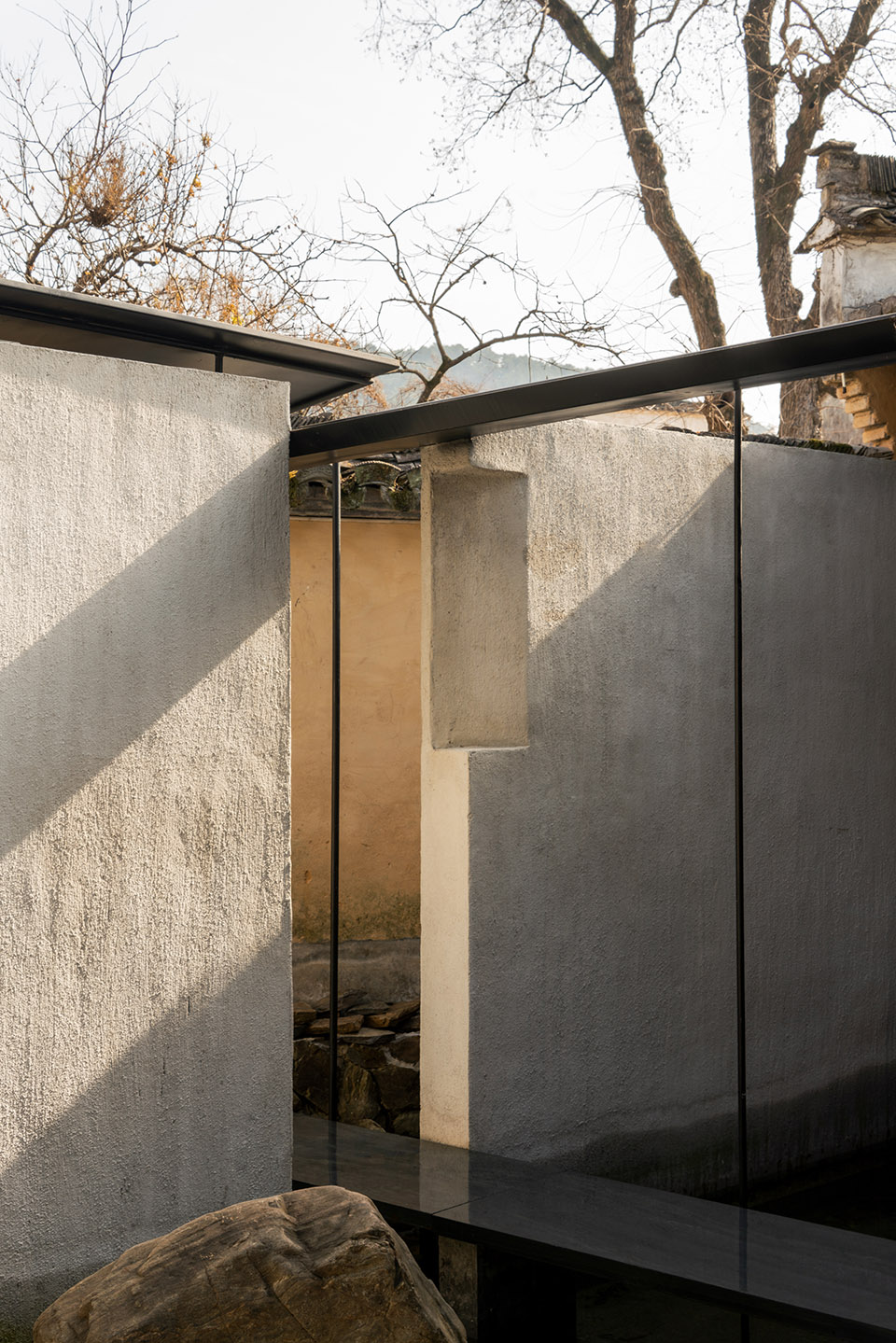
▼空间轴测图,spatial axonometric ©边界空间设计
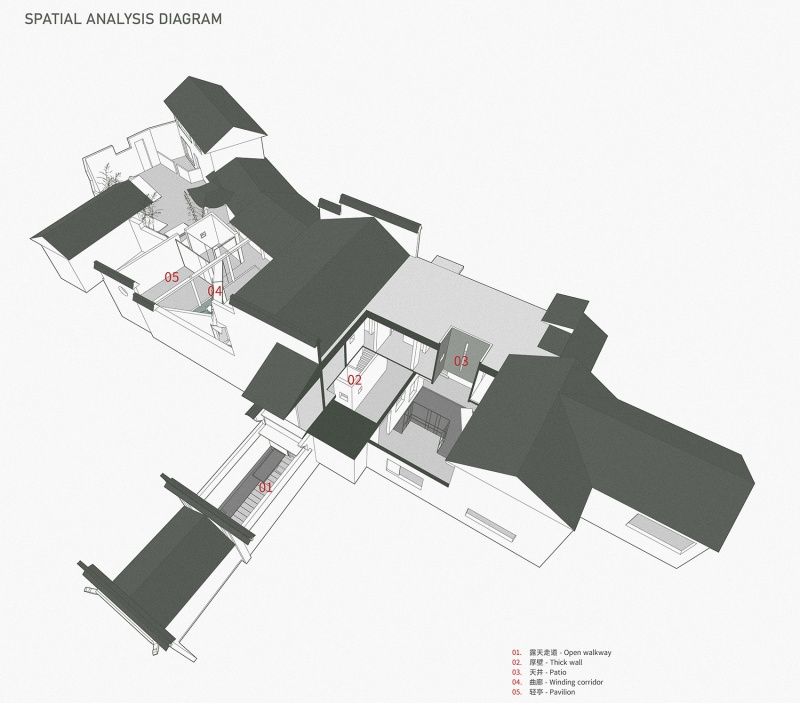
▼1F平面图,ground floor plan©边界空间设计
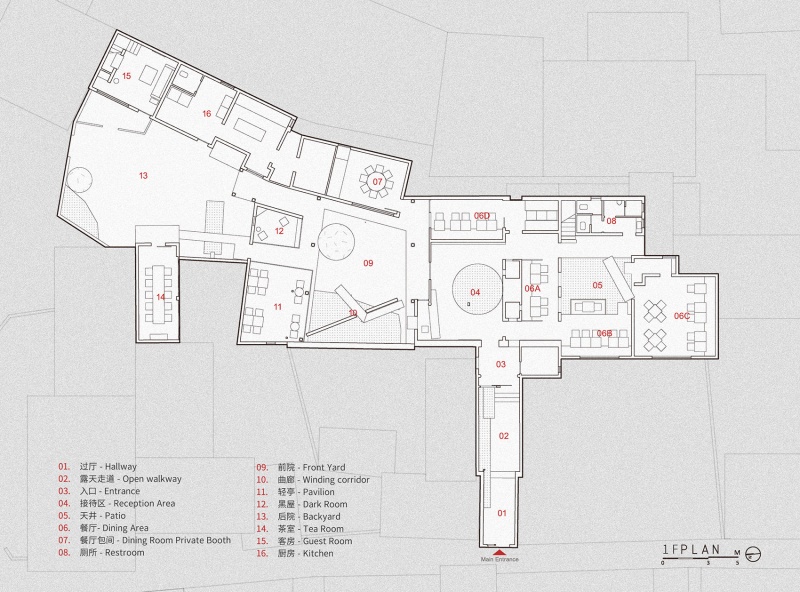
▼2F平面图,first floor plan©边界空间设计
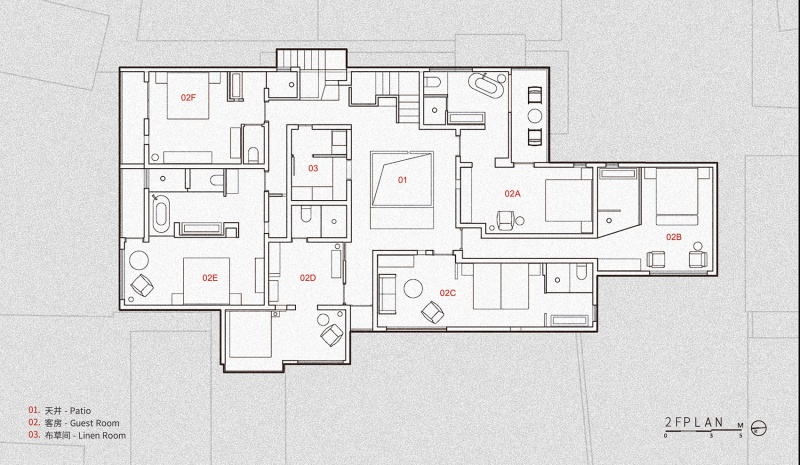
项目名称:岚叶和庭餐宿
设计单位:边界空间设计
公司地址:杭州市江汉路1785号双城国际1号楼401室
项目完成年份:2023
建筑面积:700 ㎡
项目地点:安微宏村
主持设计:黄三秀
项目摄影:汪敏杰
设计团队: 黄三秀、施甫、宋帅奇、高巍东、叶惠雄
委托方: 岚叶和庭
施工方: 黄忠伟(钢材)、江美容(木工)、查国础(泥工)等
材料:钢、瓷砖、马赛克、金属板、钢网、橡木板










